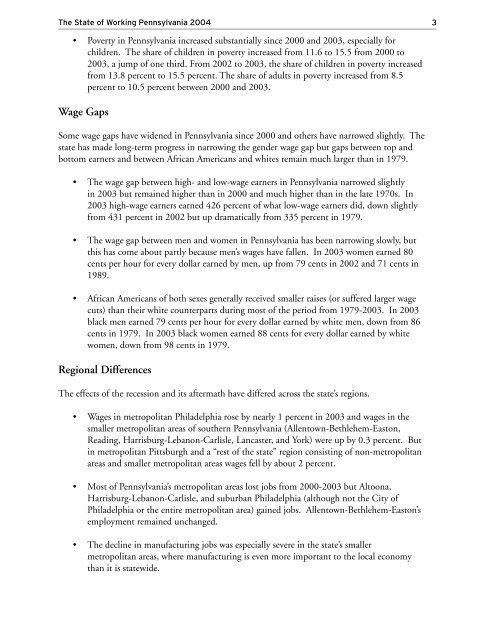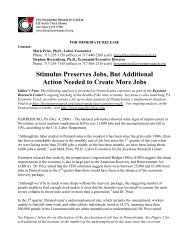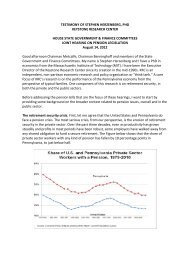The State of Working Pennsylvania 2004 - The Keystone Research ...
The State of Working Pennsylvania 2004 - The Keystone Research ...
The State of Working Pennsylvania 2004 - The Keystone Research ...
You also want an ePaper? Increase the reach of your titles
YUMPU automatically turns print PDFs into web optimized ePapers that Google loves.
<strong>The</strong> <strong>State</strong> <strong>of</strong> <strong>Working</strong> <strong>Pennsylvania</strong> <strong>2004</strong> 3<br />
• Poverty in <strong>Pennsylvania</strong> increased substantially since 2000 and 2003, especially for<br />
children. <strong>The</strong> share <strong>of</strong> children in poverty increased from 11.6 to 15.5 from 2000 to<br />
2003, a jump <strong>of</strong> one third. From 2002 to 2003, the share <strong>of</strong> children in poverty increased<br />
from 13.8 percent to 15.5 percent. <strong>The</strong> share <strong>of</strong> adults in poverty increased from 8.5<br />
percent to 10.5 percent between 2000 and 2003.<br />
Wage Gaps<br />
Some wage gaps have widened in <strong>Pennsylvania</strong> since 2000 and others have narrowed slightly. <strong>The</strong><br />
state has made long-term progress in narrowing the gender wage gap but gaps between top and<br />
bottom earners and between African Americans and whites remain much larger than in 1979.<br />
• <strong>The</strong> wage gap between high- and low-wage earners in <strong>Pennsylvania</strong> narrowed slightly<br />
in 2003 but remained higher than in 2000 and much higher than in the late 1970s. In<br />
2003 high-wage earners earned 426 percent <strong>of</strong> what low-wage earners did, down slightly<br />
from 431 percent in 2002 but up dramatically from 335 percent in 1979.<br />
• <strong>The</strong> wage gap between men and women in <strong>Pennsylvania</strong> has been narrowing slowly, but<br />
this has come about partly because men’s wages have fallen. In 2003 women earned 80<br />
cents per hour for every dollar earned by men, up from 79 cents in 2002 and 71 cents in<br />
1989.<br />
• African Americans <strong>of</strong> both sexes generally received smaller raises (or suffered larger wage<br />
cuts) than their white counterparts during most <strong>of</strong> the period from 1979-2003. In 2003<br />
black men earned 79 cents per hour for every dollar earned by white men, down from 86<br />
cents in 1979. In 2003 black women earned 88 cents for every dollar earned by white<br />
women, down from 98 cents in 1979.<br />
Regional Differences<br />
<strong>The</strong> effects <strong>of</strong> the recession and its aftermath have differed across the state’s regions.<br />
• Wages in metropolitan Philadelphia rose by nearly 1 percent in 2003 and wages in the<br />
smaller metropolitan areas <strong>of</strong> southern <strong>Pennsylvania</strong> (Allentown-Bethlehem-Easton,<br />
Reading, Harrisburg-Lebanon-Carlisle, Lancaster, and York) were up by 0.3 percent. But<br />
in metropolitan Pittsburgh and a “rest <strong>of</strong> the state” region consisting <strong>of</strong> non-metropolitan<br />
areas and smaller metropolitan areas wages fell by about 2 percent.<br />
• Most <strong>of</strong> <strong>Pennsylvania</strong>’s metropolitan areas lost jobs from 2000-2003 but Altoona,<br />
Harrisburg-Lebanon-Carlisle, and suburban Philadelphia (although not the City <strong>of</strong><br />
Philadelphia or the entire metropolitan area) gained jobs. Allentown-Bethlehem-Easton’s<br />
employment remained unchanged.<br />
• <strong>The</strong> decline in manufacturing jobs was especially severe in the state’s smaller<br />
metropolitan areas, where manufacturing is even more important to the local economy<br />
than it is statewide.







